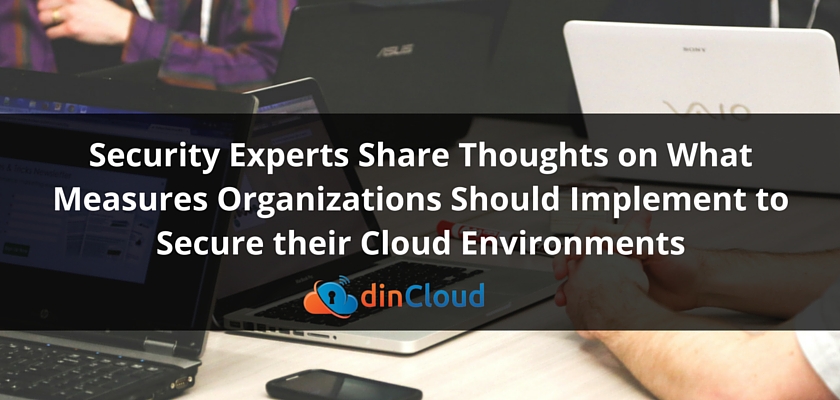Cloud security has always been a hot topic, especially more recently when you consider the multiple high profile outages with large cloud providers like Amazon, GoDaddy, and Google Aps.

Generally speaking, most cloud providers are quite reliable compared to a company running its own servers on premises. In a recent report, Forrester Research said that companies will spend $2 billion over the next five years to protect their data in the cloud. Whether you decide to have a cloud service provider run your IT infrastructure or take the DIY route, there are a number of security measures organizations can implement to safeguard their cloud infrastructure.
We polled several security experts who shared their thoughts on some of the measures organizations should put in place in order to make sure their cloud environment is secure. Here’s what they had to say…
Jason Bystrak, Executive Director the Americas, Ingram Micro Cloud, and Erik Walczak, Field Technical Consultant, Management and Security Solutions at Ingram Micro
 “In our opinion, the most challenging aspect of security not only rests in its requirement for a multi-layered technical approach, but the awareness and involvement needed from everyone in the organization. To get the obvious out the way, we highly recommend every organization has endpoint security, anti-spam, message archiving, and firewall and perimeter defense (such as intrusion detection and prevention, single sign-on, and mobile device management) implemented into their security strategy. Also, with the cloud IaaS model, scaling and managing resources can be as simple as a few clicks. Make sure you are properly organizing your user and group accounts so access and control rights are only granted to specific people. Otherwise, you might wake up one day and realize someone accidentally deleted your environment, or added a plethora of resources – mishaps that happen regularly, but can be easily avoided.”
“In our opinion, the most challenging aspect of security not only rests in its requirement for a multi-layered technical approach, but the awareness and involvement needed from everyone in the organization. To get the obvious out the way, we highly recommend every organization has endpoint security, anti-spam, message archiving, and firewall and perimeter defense (such as intrusion detection and prevention, single sign-on, and mobile device management) implemented into their security strategy. Also, with the cloud IaaS model, scaling and managing resources can be as simple as a few clicks. Make sure you are properly organizing your user and group accounts so access and control rights are only granted to specific people. Otherwise, you might wake up one day and realize someone accidentally deleted your environment, or added a plethora of resources – mishaps that happen regularly, but can be easily avoided.”
 “By far the most important thing any enterprise moving to the cloud can do is decide who shouldn’t have access to the resources in the cloud and denying access based on this. If, for example, the organization never expects its cloud resources to be accessed by people in China or Eastern Europe, then blocking all access to these resources from those locations provides a huge amount of security at very little cost. Similarly, it makes sense to block known scanners, even if they scan (currently) for ports of protocols that you do not use. As seen with Heartbleed and Shellshock, once a new exploit becomes available, malicious actors use their existing infrastructure to scan everything they can find for that vulnerability. By blocking all access to your cloud resources from places you don’t need access from and known bad actors, you get protection against zero days and also see significantly lower resource utilization overall.”
“By far the most important thing any enterprise moving to the cloud can do is decide who shouldn’t have access to the resources in the cloud and denying access based on this. If, for example, the organization never expects its cloud resources to be accessed by people in China or Eastern Europe, then blocking all access to these resources from those locations provides a huge amount of security at very little cost. Similarly, it makes sense to block known scanners, even if they scan (currently) for ports of protocols that you do not use. As seen with Heartbleed and Shellshock, once a new exploit becomes available, malicious actors use their existing infrastructure to scan everything they can find for that vulnerability. By blocking all access to your cloud resources from places you don’t need access from and known bad actors, you get protection against zero days and also see significantly lower resource utilization overall.”
Francis Turner, VP Research and Security, ThreatSTOP
 “As the cloud pulls enterprise IT service delivery off –premise and out to the edge, security becomes extremely important. Enterprise customers moving to the cloud should look for situations where they can establish a direct connection to cloud service providers. This will not only increase their security, but it will also boost performance of their cloud-based applications.”
“As the cloud pulls enterprise IT service delivery off –premise and out to the edge, security becomes extremely important. Enterprise customers moving to the cloud should look for situations where they can establish a direct connection to cloud service providers. This will not only increase their security, but it will also boost performance of their cloud-based applications.” Jim Poole, Vice President, Global Service Providers at Equinix
Jim Poole, Vice President, Global Service Providers at Equinix
For more on this topic, visit our Cloud security page.


